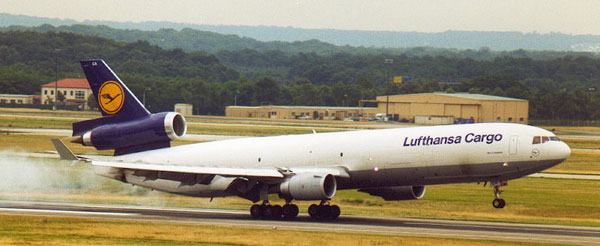Trade
Lanes Builds Better Routes

Except for a military operation where cost/revenue
considerations are nil, logistics has always had to wrestle with the same
problem: the age-old imbalance in flow of goods.
Evening
out traffic flows in cargo has been a challenge since Marco Polo planned
his roundtrips over water, and during the heyday of the old Silk Road or
even since the time of sailing ships, and tramp steamers that followed.
Volatility of modern global trade patterns
is fascinating.
Production of consumer
goods can move from Taiwan to Mainland China or Korea in the course of a
few months.
A new law in Brazil stipulating for example,
consumption, forces all countries along the line doing business in that
particular market to change procedures – with logistic services in
all modes required to change and operate under new rules.
The transportation industry in general, and air
cargo in particular is an ongoing barometer of economic changes in world
markets.
As
the global trading village draws even closer, and trade patterns constantly
shift, normal airline planning cycles that used to be created for six month
periods following the summer/winter schedule periods have been slashed.
Everywhere air cargo management is realigning
itself to stay abreast or ahead of markets in order to make the flights
profitable.
Lufthansa Cargo AG despite
many other pressures continues to grow and operate aircraft on a variety
of routes.
Gone is the time when shippers
and agents were in accordance at origin and destination.
Today
multinational manufacturing companies control and steer immense plant-to-plant
traffic around the world.
Multinational
logistics providers follow them establishing operating centers where the
action is.
Air carriers have to do the
same if they want to stay in the game of moving merchandise or components.
Some carriers noting the action on a
particular lane segment will simply put a freighter on a route figuring
that a reasonable yield can be generated.
The
problem even on some good routes is that overcapacity rules along with collateral
destruction of decent rates.
The most
important partners for air carriers in international cargo are multinational
global logistics providers.
They have
mostly been put in charge to feed the manufacturers’ and trader’s
supply chains.
The carrier and forwarder
selection nowadays is taking origin and destination criteria into equal
consideration.
For an airline like Lufthansa
Cargo AG, the task is to weigh the role of the logistics partners at both
ends of a flight.
On one hand, sales
people are often unaware of profitability.
On
the other hand, network operations people do not necessarily know what a
market holds.
A facilitator is needed
as a bridge to link these two needs equipped with decision-making power.
Lufthansa Cargo created Trade Lane Management
for the triad Asia-Europe-America market in mid 2005, based in Frankfurt.
The target for Lufthansa Trade Lane Management
is to make flight rotations profitable – especially those of freighter
aircraft; to optimize yield and load factor on each of the segments en route.
Trade Lane Management reports to Shanghai,
Singapore, Tokyo and Delhi in the east.
In
the Americas decisions are taken in Atlanta and Sao Paolo.
 This
guarantees that “differences in local approaches are observed and
considered at all times,” according to Hugo Duchemin, Trade Lane Manager
North Atlantic. This
guarantees that “differences in local approaches are observed and
considered at all times,” according to Hugo Duchemin, Trade Lane Manager
North Atlantic.
“We have to be
totally aware of specific market conditions.
“India
for example is a totally import-driven market.
“Major
U.S. and multinational corporations prefer centralized control for example.”
Mr. Duchemin stresses that logistics
providers play a very prominent role in carrier selection and rate negotiations.
“Lufthansa Cargo Trade Lane Management
Atlantic traffic has to talk to the local airfreight managers of the partners
in Europe and in America.
“Best
case is to have one single central partner, a global head of air cargo like
for example Klaus Jaeger at UTi-headquarters.
 “Asia
requires a different approach,” says Annette Kreuziger, Trade Lane
Manager Greater China. “Asia
requires a different approach,” says Annette Kreuziger, Trade Lane
Manager Greater China.
“Asian air
carriers as well as forwarders actually never had to worry about loads –
the freight was just there.
“But
growth is automatically limited by lack of profitability for every single
aircraft rotation.
“A good example
is an MD-11 freighter roundtrip Munich-Hong Kong.
“Outbound
Europe there is far too much capacity in the market resulting in incredible
price deflation.
“China is the
classic imbalance as loads out of China are continuously high.”
 In
some cases rates have gone up coupled with reduction of frequency and capacities
offered to the market, as fuel and other factors squeeze profits. In
some cases rates have gone up coupled with reduction of frequency and capacities
offered to the market, as fuel and other factors squeeze profits.
Geoffrey Arend, publisher and editor in chief of Air Cargo News and
FlyingTypers, right, deeply involved in an interesting shoptalk about
the philosophy of Trade Lane Management in airfreight.
Counterparts are the respective managers of Lufthansa Cargo, Annette Kreuziger
in charge for the Greater China market and Hugo Duchemin left –
always with an eye on the North Atlantic routes.
“Best remedy is to connect traffic
flows in the entire industry to maintain smooth supply chains in imports
as well as exports,” Annette Krueziger said.
“Our target is to increase revenues
on an aircraft rotation,” Hugo Duchemin notes.
“While our local people at the export
end sell with a regional interest in mind – central trade lane management
consults and offers new ways to connect both ends.
“Today’s global market requires
a global approach in decision -making communication between all partners
in the transportation chain. “The trade lane concept assures optimal
relation between cost & revenues allowing Lufthansa Cargo the ability
of offering two-way contracts as a package.
“Blocked space agreements with leading
agents are a great tool since a high percentage of control is being outsourced
from shippers and consignees into other hands.”
Günter Mosler |



